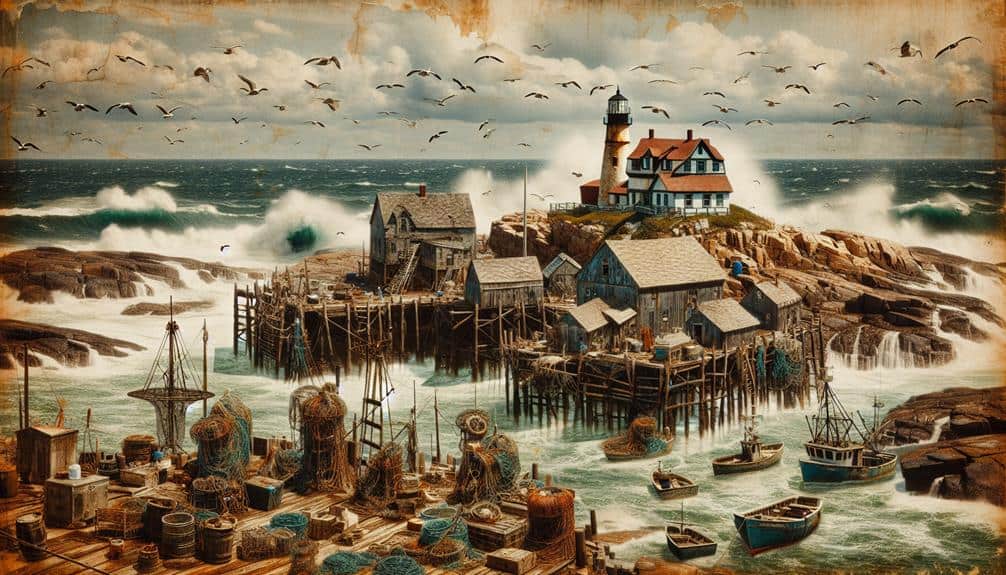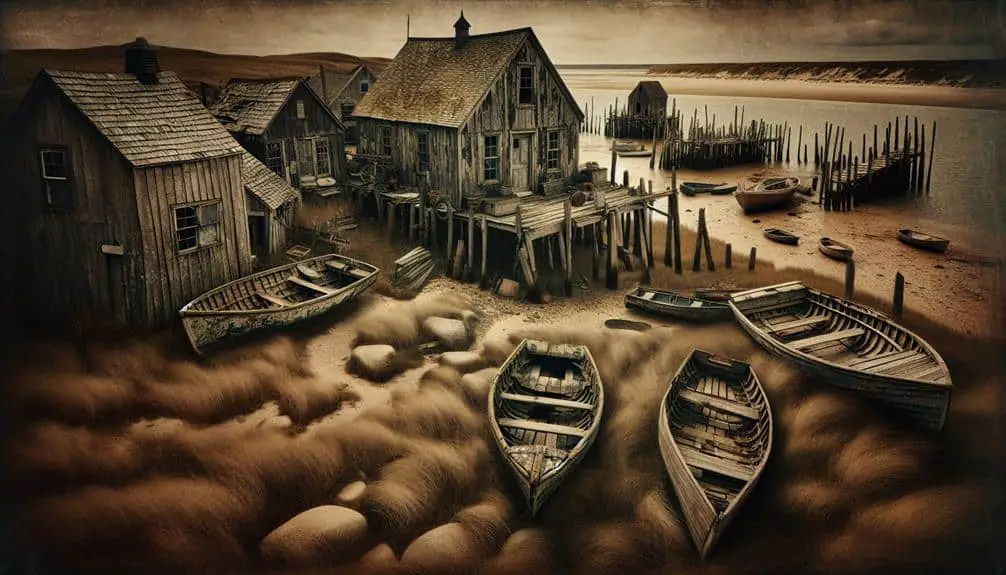Explore Maine's forgotten fishing hamlet along the rugged coast, a glimpse into a bygone era where economic revival feels like a dream. Investigate Alaska's derelict whaling outpost, where wildlife thrives amidst decaying structures. Witness the lost shrimping village of Louisiana, abandoned streets echoing a once-bustling hub. Discover Georgia's abandoned oyster community, with a rich history waiting to be uncovered. Step into Massachusetts' historic cod-fishing town, a tribute to a thriving industry. Each village holds stories of economic decline and cultural significance, frozen in time, awaiting your exploration of America's coastal past.
Key Points
- Maine's forgotten fishing hamlet: Cultural preservation efforts revive memories of a once-thriving fishing industry.
- Derelict whaling outpost in Alaska: Wildlife exploration among decaying structures and whale bones evoke a haunting past.
- Lost shrimping village of Louisiana: Abandoned streets echo the decline of a bustling shrimping hub.
- Abandoned oyster community in Georgia: Rich history, traditional techniques, and potential revitalization through conservation.
- Historic cod-fishing town in Massachusetts: Tribute to a thriving cod industry, challenges of fishing regulations, and importance of sustainability.
Maines Forgotten Fishing Hamlet
Nestled along the rugged coast of Maine lies a forgotten fishing hamlet, its weathered buildings echoing the stories of a bygone era. This hamlet, once a bustling hub of maritime activity, now stands as a proof to the passage of time. The economic revival of this quaint village seems like a distant dream, with the fishing industry that once sustained it now a mere memory. However, hope glimmers on the horizon as efforts towards cultural preservation breathe new life into the community.
Amidst the peeling paint and creaking docks, there's a sense of resilience that pervades the air. The villagers, deeply rooted in tradition, are determined to preserve their heritage while finding innovative ways to revitalize their economy. Through initiatives that blend the old with the new, this hamlet is slowly but steadily making its mark once again.
As you wander the cobblestone streets and listen to the whispers of the sea, you can't help but feel inspired by the spirit of this forgotten fishing hamlet. It serves as a reminder that with perseverance and a deep respect for tradition, economic revival and cultural preservation can go hand in hand, breathing new life into even the most forgotten corners of the world.
Derelict Whaling Outpost in Alaska
Located on a remote stretch of Alaskan coastline, the derelict whaling outpost stands as a haunting reminder of a once-thriving industry now lost to time. As you explore this desolate place, remnants of a bygone era come into view, painting a vivid picture of the harsh realities faced by those who once inhabited this rugged land.
- Exploring wildlife: Amidst the decaying structures, nature has reclaimed its hold, offering a glimpse of the resilience of the surrounding ecosystem.
- Historical artifacts: Weathered harpoons, rusted machinery, and crumbling buildings serve as silent witnesses to the toils of the whalers who once called this place home.
- Whale bones scattered: Scattered whale bones on the shore evoke a sense of both wonder and sorrow, a stark reminder of the whaling activities that once thrived here.
- Echoes of the past: The howling winds seem to carry echoes of past hardships, whispering stories of daring hunts and arduous voyages.
- Isolated beauty: Despite its abandonment, the outpost exudes a rugged beauty, offering a glimpse into a chapter of history now frozen in time.
Lost Shrimping Village of Louisiana
Once a bustling hub of shrimping activity, the now deserted village in Louisiana stands as a poignant evidence to the decline of a once-thriving industry. Nestled along the Louisiana coast, this lost community was once vibrant with the sounds of boats coming and going, fishermen hauling in their daily catch, and the bustling activity of a shrimping industry that sustained generations. However, as the demand for shrimp shifted, and environmental challenges arose, this village faced a steady decline that eventually led to its abandonment.
The remnants of this once-thriving shrimping village tell a story of resilience and adaptation in the face of changing tides. Empty shacks, rusted equipment, and overgrown docks serve as a haunting reminder of the community that once thrived here. Walking through these abandoned streets, you can almost hear the echoes of a bygone era, where hardworking fishermen toiled to make a living from the sea.
Despite its current state of desolation, the lost shrimping village of Louisiana stands as a demonstration to the ebb and flow of industries, the resilience of coastal communities, and the ever-changing nature of life along the coast.
Abandoned Oyster Community in Georgia
Explore the rich history of oystering in the abandoned community of Georgia, shedding light on the traditional practices and the cultural significance of this once-thriving industry.
Analyze the environmental impact of the community's abandonment, discussing the ecological changes that have occurred since its decline.
Consider the potential for revitalization in this area, weighing the economic and social benefits that could come with restoring the oyster community to its former glory.
Rich History of Oystering
Nestled along the intricate waterways of the Georgia coast, the abandoned oyster community stands as a poignant reminder of the rich history of oystering in the region. Oyster farming has been a crucial part of coastal preservation efforts, shaping both the environment and the economy.
- Traditional Harvesting Techniques: Handpicking oysters from the seabed.
- Community Culture: Close-knit relationships among oyster fishermen.
- Economic Significance: Oyster trade as a primary income source for locals.
- Environmental Influence: Oyster reefs promoting marine biodiversity.
- Decline Factors: Overfishing and environmental changes leading to community abandonment.
Environmental Impact of Abandonment
The abandonment of the oyster community in Georgia has left a profound environmental legacy, shaping the delicate coastal ecosystem in unforeseen ways.
The departure of residents has led to a significant impact on wildlife, with once-thriving habitats now struggling to sustain diverse species. Coastal erosion has accelerated in the absence of human intervention, causing further disruption to the natural balance of the area.
Additionally, the economic repercussions of the abandonment have been severe, as the community's departure has resulted in lost revenue from oyster harvesting and related industries. Furthermore, the displacement of the community has left behind a ghost town, devoid of its once-vibrant culture and traditions.
The environmental effects of this abandonment serve as a stark reminder of the interconnectedness between human presence and the well-being of coastal ecosystems.
Potential for Revitalization
Amidst the abandoned oyster community in Georgia lies a potential for revitalization that hinges on strategic conservation efforts and community engagement. The once-thriving village, with its rich cultural heritage and ties to the sea, could see a revival through careful planning and involvement from local residents and stakeholders.
- Preservation Efforts: Implementing measures to protect the historical structures and landscapes.
- Economic Opportunities: Exploring sustainable ways to leverage the area's resources for economic growth.
- Community Engagement: Involving residents in decision-making processes and revitalization efforts.
- Cultural Significance: Recognizing and honoring the community's history and traditions.
- Tourism Development: Promoting the village as a unique destination for visitors interested in coastal heritage.
Historic Cod-Fishing Town in Massachusetts
Surrounded by the rich history of the Atlantic cod fishery, this Massachusetts town stands as a tribute to the once-thriving industry that shaped its identity. The historic preservation efforts in this coastal gem have allowed visitors to step back in time and witness the legacy of the cod-fishing era. Walking through the abandoned streets, you can almost hear the echoes of fishermen discussing their daily hauls and the bustling sounds of the harbor filled with fishing vessels.
The economic impact of the cod industry on this town was profound, providing livelihoods for generations of families and creating a vibrant community centered around the sea. However, as the cod population dwindled and fishing regulations tightened, the town faced challenges that eventually led to its abandonment.
Exploring the remnants of this historic cod-fishing town offers a glimpse into a bygone era, reminding us of the importance of sustainable practices in preserving our coastal heritage. As you wander through the abandoned buildings and silent docks, you can't help but feel a sense of reverence for the once-thriving industry that defined this community.
Deserted Tuna Hub in California
Nestled along the California coast lies a forsaken tuna hub, once teeming with life and commerce but now eerily quiet and abandoned. The deserted tuna hub in California stands as a poignant reminder of the ebb and flow of coastal communities.
- Economic Impact: The hub's closure left a void in the local economy, impacting jobs and businesses that relied on the tuna industry.
- Cultural Significance: Once a vibrant center of fishing traditions and cultural exchange, the hub now sits silent, its stories echoing through the empty streets.
- Coastal Preservation: Efforts to preserve the area's coastal beauty face challenges in balancing conservation with the hub's historical legacy.
- Community Engagement: Local initiatives aim to revitalize the area, fostering community involvement in restoring the hub to its former glory.
- Historical Heritage: The hub's abandonment raises questions about the preservation of maritime history and the importance of remembering the past for future generations.
Empty Crabbing Settlement in Oregon
Explore the once-thriving community of Oregon's Lost Crabbers, where the echoes of bustling docks and the scent of the sea linger in the air.
Witness the haunting coastal desolation that now envelops this forgotten crabbing settlement, a stark reminder of the transient nature of fishing traditions.
Immerse yourself in the quiet melancholy of a place frozen in time, where the legacy of hardworking fishermen fades into the whispers of the wind.
Oregons Lost Crabbers
Amidst the rugged Oregon coastline lies an abandoned crabbing settlement, once bustling with activity but now standing empty and silent. The impact of globalization and the struggle for cultural preservation have left this place frozen in time. As you explore this ghostly village, you can't help but feel a sense of melancholy and curiosity about its past.
Here are a few intriguing aspects worth pondering:
- Weathered crab traps scattered along the shore.
- Faded murals depicting the life of the crabbers.
- Empty shells of boats slowly decaying in the harbor.
- Dilapidated shacks once filled with laughter and stories.
- A lone lighthouse standing tall, a silent witness to the village's decline.
Haunting Coastal Desolation
The desolate remnants of the abandoned crabbing settlement in Oregon evoke a haunting sense of bygone industry and community, frozen in time amidst the rugged coastal landscape. As you wander through the empty shacks and rusted equipment, a feeling of eerie solitude envelops you, whispering stories of a once-thriving fishing village now lost to the relentless tides of change.
The salty breeze carries echoes of coastal nostalgia, reminding you of the days when fishermen would return with their daily catch, their laughter mingling with the cries of seagulls. Now, only the creaking of weather-beaten structures breaks the silence, a poignant reminder of the fleeting nature of human endeavors in the face of nature's unforgiving forces.
Forgotten Fishing Traditions
Nestled along the rugged Oregon coast lies the empty crabbing settlement, a poignant reminder of forgotten fishing traditions that once thrived in this coastal community. As you explore this abandoned village, you can almost hear echoes of a time when fishermen relied on ancient techniques to harvest the sea's bounty. The air is tinged with nostalgia for a bygone era when coastal life was intertwined with the ebb and flow of the ocean.
- Forgotten Fishing Techniques: Discover the lost art of traditional crabbing methods.
- Weathered Fishing Gear: Rusty traps and worn nets tell stories of past fishing expeditions.
- Community Gathering Spots: Uncover where fishermen once shared tales of the sea.
- Coastal Preservation Efforts: Learn about initiatives to protect the maritime heritage of this area.
- Fading Maritime Culture: Witness how modernization has eroded age-old fishing customs.
Vanished Lobstering Village in New Hampshire
Once bustling with lobster fishermen and their vibrant community, the vanished lobstering village in New Hampshire now stands as a haunting reminder of a bygone era. Nestled along the rugged New England coast, this village was once a hub of lobstering activity, where fishermen set out at dawn and returned with their catch as the sun dipped below the horizon. The village's history is shrouded in tales of hard work, camaraderie, and a deep connection to the sea.
Despite its abandonment, efforts towards history preservation and community engagement have been made to keep the memory of this once-thriving village alive. Local historical societies organize guided tours, storytelling sessions, and annual events that celebrate the rich heritage of the lobstering community. These initiatives not only honor the past but also bring people together in a shared appreciation for the sacrifices and traditions of those who called this place home.
Walking through the deserted streets and dilapidated lobster shacks, you can almost hear the echoes of laughter and the creaking of fishing boats, a poignant reminder of a time when this village was alive with the spirit of a close-knit community united by the sea.
Uninhabited Scallop Port in Virginia
Amidst the serene shores of Virginia lies an uninhabited scallop port, its once bustling docks now silent and devoid of the vibrant activity that once defined it. The history of this port is steeped in the scallop industry, where fishermen once brought in their daily catch, supporting a thriving local economy. However, due to overfishing and insufficient conservation efforts, the scallop population dwindled, leading to the eventual abandonment of the port.
- Challenges Faced: The port struggled with declining scallop populations, forcing fishermen to venture further out to sea.
- Conservation Efforts: Despite past failures, recent initiatives aim to restore the scallop population through strict regulations and marine protected areas.
- Economic Impact: The closure of the port had a significant economic impact on the local community, leading to a decline in jobs and businesses.
- Local Community Revival: Efforts are underway to revive the community by diversifying economic activities and promoting sustainable fishing practices.
- Future Prospects: While the port remains uninhabited, there's hope for its revival through collective conservation efforts and a renewed focus on sustainable practices.
Ghostly Herring Station in Washington
The abandoned herring station in Washington stands as a haunting reminder of a once-thriving industry now lost to the passage of time and shifting economic landscapes. Nestled along the rugged shoreline, this ghostly herring station exudes an eerie atmosphere that sends shivers down your spine as you explore its decaying structures and rusted machinery.
Walking through the remnants of what was once a bustling hub of activity, you can almost hear the echoes of fishermen shouting and seagulls cawing overhead. The air is heavy with the scent of salt and decay, adding to the sense of desolation that permeates the area. Nature has begun to reclaim this forsaken place, with vines creeping up walls and seabirds making nests in the rafters.
As you gaze out at the vast expanse of the ocean, you can't help but wonder about the lives that were lived here and the stories that remain untold. The ghostly herring station stands as a silent witness to a bygone era, its presence a poignant reminder of the fleeting nature of industry and human endeavor.
Frequently Asked Questions
What Are the Potential Environmental Impacts of the Abandonment of These Coastal Fishing Villages?
When coastal fishing villages are abandoned, the potential environmental impacts include coastal erosion from lack of maintenance, pollution from decaying infrastructure, increased vulnerability to climate change effects, and habitat loss for marine species that depended on the village structures.
Are There Any Efforts Being Made to Preserve or Revitalize These Abandoned Communities?
Efforts to preserve and revitalize abandoned coastal fishing villages are ongoing. Preservation initiatives aim to safeguard history, while revitalization projects seek to breathe new life into these once-thriving communities, fostering a sense of belonging.
How Did These Once Thriving Fishing Villages Come to Be Abandoned?
Fishing villages were abandoned due to economic decline and changing industries, forcing residents to migrate. Natural disasters also played a role. These factors led to once-thriving communities becoming ghost towns, echoing a bygone era.
Are There Any Unique Cultural or Historical Aspects Associated With These Abandoned Coastal Fishing Villages?
Explore the unique cultural heritage and historical significance of abandoned coastal fishing villages. Discover the untold stories of resilience and community that shaped these forgotten places, offering a glimpse into a bygone era.
Have Any of These Abandoned Villages Been Featured in Movies, Books, or Other Forms of Media?
Explore the cinematic inspirations and literary references of these abandoned coastal fishing villages. Discover how these evocative settings have captivated storytellers across various media, adding depth and intrigue to their narratives.



